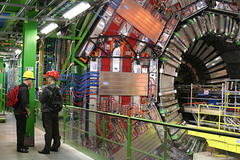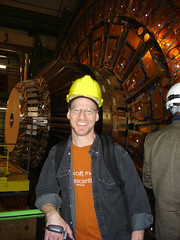This was the big day: the trip to the Large Hadron Collider.
We had quite a crew ready to go from the hotel: Gia, Brian, me, Nick, Nick’s son, Julian, and special surprise guest Chris Morris and his son. Chris is, well… he’s a brilliant satirist (some NSFW language in that link), for one thing. He’s many things, in fact, but he’s quite the science junkie and was loaded with questions about quantum mechanics and relativity, which led for an entertaining day. After breakfast, we all piled into the weird boxy van Brian rented and off to CERN we went.
 Our first stop was ATLAS, which dubiously stands for A Toroidal LHC ApparatuS, one of two detectors in the LHC. A pretty good description can be found on the ATLAS wikipedia page, but maybe a bit of background is called for. The LHC is designed to smack protons together head-on at speeds just a whisper under the speed of light. Packets containing millions of protons are guided through evacuated pipes that are cooled down to a mere 2 Kelvins above absolute zero – colder than space itself. There are in fact two beams, each about the width of a pencil, moving in opposite directions around the pipes. At a certain point, the beams are squeezed into even narrower beams, about the width of a human hair, and then the two beams are crossed into each other*. The packets of protons pass through each other, and when they do at least two but as many as 60 protons collide head-on. When they do, they essentially shatter into smaller subatomic particles. The number, variety, and energies of these fragments are what give scientists insight into the bizarre world of quantum mechanics.
Our first stop was ATLAS, which dubiously stands for A Toroidal LHC ApparatuS, one of two detectors in the LHC. A pretty good description can be found on the ATLAS wikipedia page, but maybe a bit of background is called for. The LHC is designed to smack protons together head-on at speeds just a whisper under the speed of light. Packets containing millions of protons are guided through evacuated pipes that are cooled down to a mere 2 Kelvins above absolute zero – colder than space itself. There are in fact two beams, each about the width of a pencil, moving in opposite directions around the pipes. At a certain point, the beams are squeezed into even narrower beams, about the width of a human hair, and then the two beams are crossed into each other*. The packets of protons pass through each other, and when they do at least two but as many as 60 protons collide head-on. When they do, they essentially shatter into smaller subatomic particles. The number, variety, and energies of these fragments are what give scientists insight into the bizarre world of quantum mechanics.
They’re hoping to find evidence of the Higgs boson, an as-yet theoretical particle that is thought to give particles like protons their mass. No one understands why particles have mass, but if the Higgs is found, then so is the answer. It’s one of the most basic questions in all of physics… and we may know the solution shortly after LHC is up and running.
ATLAS is one of two detectors designed to see what particles come out of the collisions. Brian works with ATLAS, in fact. ATLAS is very very very very big. I mean very big. I couldn’t fit it all in one picture, even from many meters away! The sheer size of ATLAS is a bit overwhelming, but then, so is everything about the LHC. The accelerator itself is vast: it’s a ring of pipes 27 kilometers around, a circle about 8.5 kilometers across. The energies are fantastic as well. The protons zip around the ring 11000 times per second – for comparison, it took us about a half hour to drive across the ring. Funny… each proton has about the same energy as a mosquito hitting you on the forehead, which doesn’t sound like much, but we’re talking about an object only about 10-15 times the size of a mosquito. The entire beam energy of the LHC is equivalent to an aircraft carrier moving at 50 kilometers per hour! If something were to go wrong in the beam, it would tear a hole in the pipe containing it. Good thing it’s 100 meters underground.
After visiting ATLAS we went across the ring to CMS, the Compact Muon Spectrometer, the other detector. CMS is also really big, but only half the size of ATLAS. This means we could actually get pictures of it that fit in the frame… more or less The picture on the left is Brian interviewing me for the CERN podcast (directed by Julian; I’ll link to it when it goes live). One half of CMS is in the background. CMS is currently split in half, a bit like a cut orange, awaiting some final preparation before the two halves are slid together.
It’s difficult to convey just how astonishing this all is. The scale of it is simply awesome. Standing off to the side, taking in the size and complexity of CMS and ATLAS, I was filled with a sense of pride. People built this! Every single cable (and there were miles of cable!), every rivet, every bolt, every iron block and metal plate, everything, was dreamed up, designed, redesigned, built, and assembled.
 Some people have their issues with science; they think it’s a haphazard, random, and essentially directionless process done by cold-blooded, emotionless scientists. Standing in the LHC puts the lie to that thought. As you drink in the components of this fantastic apparatus, there is an almost overwhelming sense of purpose to all of it, a knowledge that this intricate and amazing machine was built, and its one goal, the only thing it really is designed to do, is further our knowledge of how the Universe works. Humans did this, humans desired to seek out this learning, humans proposed it, humans funded it, humans built it.
Some people have their issues with science; they think it’s a haphazard, random, and essentially directionless process done by cold-blooded, emotionless scientists. Standing in the LHC puts the lie to that thought. As you drink in the components of this fantastic apparatus, there is an almost overwhelming sense of purpose to all of it, a knowledge that this intricate and amazing machine was built, and its one goal, the only thing it really is designed to do, is further our knowledge of how the Universe works. Humans did this, humans desired to seek out this learning, humans proposed it, humans funded it, humans built it.
And humans will learn from it. That’s what we do.
 And as far as “emotionless” goes… well. I dare you: stand there, deep underground, surrounded by the physical manifestation of the desire to learn, looking at 2000 tons of magnet, electronics, and infrastructure, knowing that in a few months, mere meters from where you are standing, subatomic particles too small to see will recreate the conditions that existed just the tiniest fraction of a second after the Universe itself exploded into existence. If you don’t feel an overwhelming sense of pride and accomplishment, of awe and majesty, then you’d better check your pulse. You must be dead.
And as far as “emotionless” goes… well. I dare you: stand there, deep underground, surrounded by the physical manifestation of the desire to learn, looking at 2000 tons of magnet, electronics, and infrastructure, knowing that in a few months, mere meters from where you are standing, subatomic particles too small to see will recreate the conditions that existed just the tiniest fraction of a second after the Universe itself exploded into existence. If you don’t feel an overwhelming sense of pride and accomplishment, of awe and majesty, then you’d better check your pulse. You must be dead.
No emotionless person could have ever built LHC, could have ever imagined it. It exists because of emotion – joy, wonder, and amazement – the fuel that drives the seeking of scientific knowledge.
*Unlike in Ghostbusters, this is good.